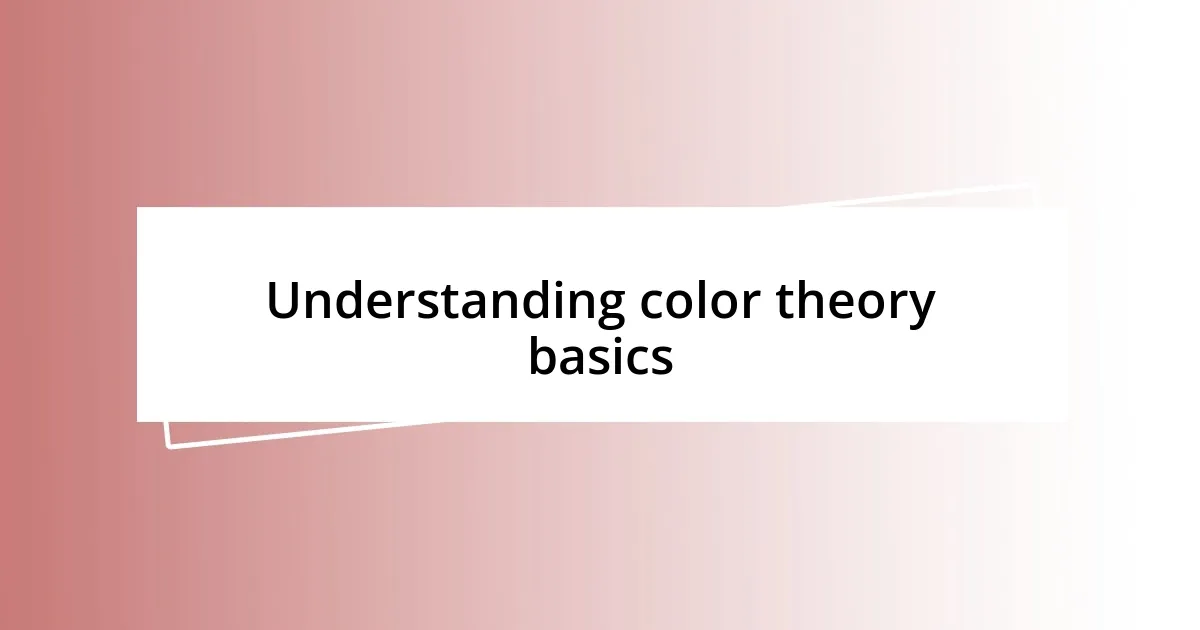Key takeaways:
- Color theory categorizes colors into primary, secondary, and tertiary, influencing mood and atmosphere in fashion and decor.
- Effective color combinations, such as complementary and triadic schemes, can enhance visuals and balance outfits.
- Utilizing neutrals with bright colors adds sophistication while maintaining the outfit’s vibrancy.
- Practical tips include using a color wheel for inspiration, starting with a statement piece, and layering different shades for depth.

Understanding color theory basics
Color theory is about understanding how colors interact and influence one another. I remember the first time I played with complementary colors in an outfit—purple and yellow. The energy was almost electric, making me feel vibrant and alive.
At its core, color theory breaks down colors into primary, secondary, and tertiary. I’ve often painted my home office, and choosing the right hue can dramatically shift the mood. Ever painted a wall a bold shade and instantly felt more creative? It’s fascinating how such choices can evoke emotions and set the entire atmosphere.
Understanding warm and cool tones is another essential aspect I’ve come to appreciate. Warm colors like red and orange can feel inviting, while cool colors like blue and green can create calmness. When I decorated for a gathering last summer, I opted for warm tones to make my guests feel more welcomed. Have you ever noticed how certain colors make you feel differently in a single space? It’s a powerful concept that really changed my approach to fashion.

Identifying color combinations that work
Identifying color combinations that work is like unraveling a personal puzzle. I’ve found that triadic color schemes, which involve three colors spaced evenly apart on the color wheel, work wonders together. The first time I experimented with orange, green, and purple, it was as if an artist had splashed a landscape in front of me. Each color popped against the others, creating a lively yet balanced look—perfect for a day out in the sun.
When it comes to combining colors, saturation and brightness play a pivotal role. Choosing colors of similar saturation can create a harmonious effect, while mixing various saturations can lead to dynamic visuals. I once paired a muted blue dress with vibrant coral accessories, and the contrast made me feel like I was walking on sunshine. Have you ever felt that boldness when you wear something that just works? It’s like wearing confidence.
Lastly, don’t underestimate the power of neutrals. Pairing a bright color with a neutral like beige or gray can ground an outfit without taking away its essence. I often turn to a classic black blazer when I want to elevate a colorful outfit, giving it an edge without overshadowing the brights. Would you believe it can transform a casual ensemble into something sophisticated?
| Color Combination | Effect |
|---|---|
| Complementary | High contrast, vibrant visuals |
| Triadic | Dynamic and balanced |
| Analogous | Harmonious and serene |
| Neutrals with bright colors | Grounded and sophisticated |

Practical tips for color application
When it comes to practical color application, one tip I always advocate for is to use a color wheel as a guide. I remember flipping through a color wheel while trying to decide on an outfit for a special event. It was eye-opening to see how easily I could find complementary colors for my favorite teal dress. Have you ever caught yourself staring into your closet, wishing for more inspiration? That little tool made it much simpler to curate outfits that felt vibrant and put-together.
Another strategy I’ve found invaluable is to start with a statement piece. I once bought a bright red scarf that instantly became the focal point of my look. I paired it with more subdued hues, and the overall effect was striking without being overwhelming. It’s great how one item can change the game—have you noticed that a single bold accessory can elevate your style? It’s all about balance and making sure your colors tell a story.
Finally, keep in mind the impact of layering different shades of the same color. I often layer navy blues and lighter blues for depth, which adds richness without chaotic clashes. It’s as if I’m building a sense of intrigue in my outfit. Have you ever felt how subtle shifts in shade can create a cohesive yet interesting aesthetic? That’s the magic of color play—it invites curiosity and keeps your style dynamic.














